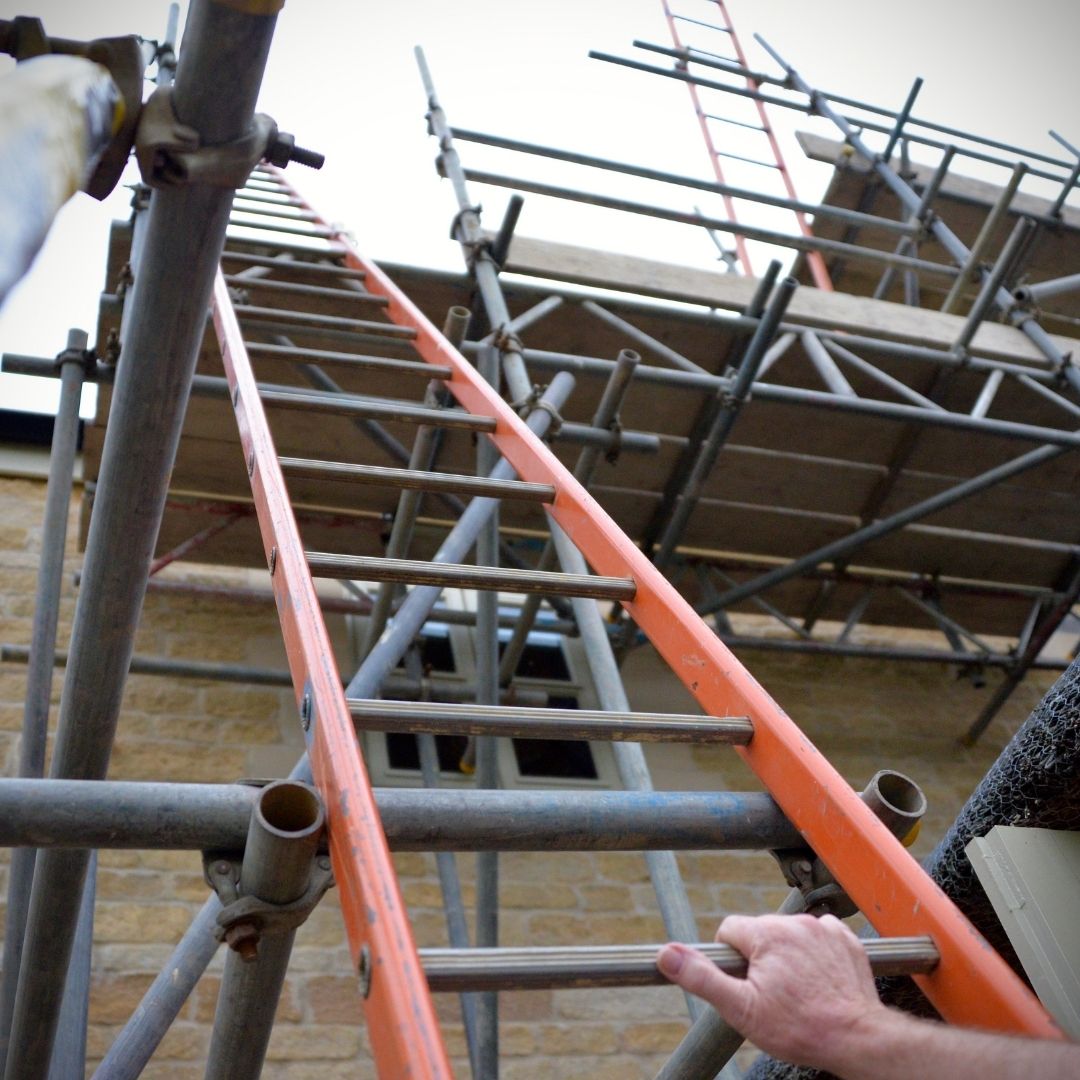Scaffolding can reach impressive heights, sometimes up to 100 meters or more. But how high can scaffolding go safely and effectively?
Construction projects often require scaffolding to access tall structures. This essential tool provides a safe platform for workers. Understanding the limits and capabilities of scaffolding is crucial. It ensures not only the safety of the workers but also the success of the project.
We will explore the maximum heights scaffolding can achieve. We will also discuss the factors that affect these heights. From regulations to materials used, knowing these details is vital. So, let’s dive into the world of scaffolding and uncover just how high it can go!

Credit: cleanmygutters.uk
Scaffolding Basics
Scaffolding can reach impressive heights, sometimes over 300 feet, depending on the project’s needs and safety standards. Building height, structure type, and local regulations influence how high scaffolding can safely go. Proper planning ensures stability and safety for workers at great heights.
### Scaffolding Basics Scaffolding is essential in construction. It provides a temporary structure for workers to access high areas safely. But, how high can scaffolding go? Let’s start with the basics. ####Types Of Scaffolding
There are various types of scaffolding. Supported scaffolding is the most common. It uses poles and frames to stay upright. Suspended scaffolding hangs from the top of a building. It’s perfect for tall structures where supported scaffolding isn’t practical. Rolling scaffolding has wheels. It is easy to move around a site. This type is great for tasks that require frequent repositioning. ####Key Components
Scaffolding has several key components. Standards are vertical poles. They bear the weight of the structure. Ledgers are horizontal poles. They connect the standards and provide stability. Transoms are horizontal bars placed across ledgers. They support the working platform. Couplers join different parts together. They ensure the structure remains secure. Think about this: Have you ever seen scaffolding that seemed to defy gravity? It’s all thanks to these key components working together. Understanding these basics can help you appreciate the engineering behind tall scaffolding structures. Next time you see scaffolding, consider the types and components involved.Engineering Principles
Scaffolding height depends on several factors, including design and materials. Proper engineering ensures safe, tall structures. Safety measures and weight distribution are crucial.
Scaffolding is a crucial component in construction, allowing workers to reach great heights safely. But have you ever wondered how these towering structures stand tall without toppling over? The answer lies in the engineering principles that govern their design and construction. Understanding these principles not only ensures safety but also maximizes the efficiency of the project. Let’s dive into some key elements that determine how high scaffolding can safely go. ###Load-bearing Capacity
The load-bearing capacity is a critical factor in scaffold engineering. It determines how much weight the structure can safely support. This includes the weight of workers, tools, and materials. Each scaffold must be designed to handle more than the maximum expected load to ensure safety. Engineers consider several variables when calculating load-bearing capacity. They look at the materials used, the width of the platforms, and the height of the scaffold. Imagine standing on a wooden board versus a steel plank—different materials offer varying levels of support. You wouldn’t want to be high up on scaffolding that hasn’t been properly assessed for weight limits, right? ###Stability Factors
Stability is the backbone of any scaffolding structure. A stable scaffold prevents accidents and provides a secure platform for work at height. Engineers achieve stability by employing several techniques. Bracing is one method used to enhance stability. It involves adding diagonal supports to the structure. Think of it like adding training wheels to a bike—it keeps everything upright. Adjustable base plates and outriggers are also employed to distribute weight evenly and prevent tipping. The question to ask is, how stable is your scaffolding? Even a small imbalance can lead to significant hazards. Paying attention to these factors can mean the difference between a smooth workflow and a dangerous situation. Understanding these engineering principles is crucial for anyone involved in construction. It ensures that scaffolding not only reaches impressive heights but does so safely and efficiently. Next time you see a tall scaffold, you’ll have a new appreciation for the intricate engineering that keeps it standing strong.Historical Context
Scaffolding has been an essential part of construction throughout history. From ancient wonders to modern skyscrapers, the need for sturdy and reliable scaffolding has remained constant. Understanding the historical context can provide insight into just how high scaffolding can go.
Ancient Structures
In ancient times, scaffolding was a crucial tool for builders. Imagine the pyramids of Egypt. These massive structures required extensive scaffolding to reach their towering heights. Historical records suggest that wooden scaffolding was used to create ramps and platforms.
The Great Wall of China is another example. Builders used bamboo scaffolding to construct this monumental structure. Bamboo’s strength and flexibility made it an ideal choice for reaching great heights. Its use is still prevalent in some parts of the world today.
Modern Innovations
Modern technology has revolutionized scaffolding. Today, aluminum and steel are the materials of choice. They offer greater strength and can support higher structures. This shift allows scaffolding to reach unprecedented heights, such as those seen with skyscrapers.
Consider the Burj Khalifa in Dubai. At 828 meters, it is the tallest building in the world. The construction involved highly advanced scaffolding techniques. Modular and mobile scaffolding systems were crucial for reaching such heights safely and efficiently.
As construction technology evolves, so does scaffolding. Innovations like automated scaffolding systems are emerging. These systems can be adjusted quickly and safely, pushing the boundaries of how high scaffolding can go.
What do you think the future holds for scaffolding? Could we see even taller structures supported by even more advanced scaffolding? Your thoughts and experiences could help shape this exciting field!
Current Limitations
Scaffolding heights face limits due to safety standards and structural stability. Wind speeds and material strength also affect maximum height. These factors ensure worker safety and prevent accidents.
Understanding how high scaffolding can go involves knowing its current limitations. While scaffolding is essential in construction, maintenance, and other industries, it doesn’t come without boundaries. Builders must consider factors like material strength, safety regulations, and site-specific conditions. These factors dictate the maximum height scaffolding can safely reach. Let’s dive into some specific limitations that affect scaffolding heights.Material Constraints
The materials used in scaffolding construction play a crucial role in determining its height capabilities. Steel and aluminum are commonly used due to their strength and durability. However, even these materials have limits. Steel scaffolding, though strong, becomes heavier as it goes higher. This adds stress to the lower sections, which can be risky if not properly supported. Aluminum scaffolding is lighter and easier to handle, but it may not offer the same load-bearing capacity as steel, especially at great heights. Innovations in material science continue to push these boundaries, but understanding the limitations of what you’re working with is vital. Have you ever found a project stalled because the scaffolding didn’t meet the height requirements? It’s a reminder that material choice is about more than just convenience.Height Restrictions
Regulations impose height restrictions on scaffolding for safety reasons. Each country and region has its own set of rules to prevent accidents and ensure stability. These rules take into account factors like wind force, ground stability, and the type of work being performed. For instance, in many areas, scaffolding over 30 feet requires additional safety measures like guardrails and tie-ins to the building structure. These restrictions are not just bureaucratic hurdles; they are essential for protecting the workers and the public. Think about the last time you saw scaffolding towering over a city skyline. Did you wonder how it managed to stay up there safely? Those height restrictions are a big part of the answer, ensuring that what goes up must be secure. Navigating these limitations requires careful planning and a deep understanding of both material capabilities and safety regulations. So next time you’re involved in a project, consider how these factors might impact your scaffolding needs. What challenges have you faced with scaffolding heights? Share your experiences and insights in the comments.Technological Advances
Technological advances allow scaffolding to reach impressive heights, ensuring safety and stability for workers. Modern materials and engineering techniques contribute to taller, more reliable structures.
Technological advances have transformed the way we think about scaffolding heights. Gone are the days when scaffolding was limited by traditional materials and manual processes. Now, with the advent of new technologies, scaffolding can reach unprecedented heights safely and efficiently.Smart Scaffolding
Smart scaffolding is a game-changer in the construction industry. Imagine scaffolding that can monitor its own stability and give real-time feedback. This technology uses sensors to detect any movement or stress, alerting workers immediately. This can prevent accidents and ensure safety at greater heights. Additionally, smart scaffolding can be adjusted remotely, reducing the need for manual intervention. Have you ever thought about how much time and effort this saves on a bustling construction site?Enhanced Materials
Enhanced materials have propelled scaffolding to new heights. Traditional materials like wood and basic metals have been replaced with lightweight yet strong composites. These materials can withstand extreme weather and heavy loads, which is crucial for tall structures. Consider the use of aluminum and fiberglass, which are not only durable but also easy to transport and assemble. This combination allows for scaffolding that is both tall and stable. What materials would you trust with your life when working hundreds of feet above the ground? These technological advances not only make scaffolding safer but also more efficient. As construction projects reach for the skies, these innovations ensure that workers can do so with confidence and ease.Safety Considerations
Scaffolding plays a crucial role in construction projects. It ensures workers can access high areas safely. The height of scaffolding is a concern, especially for safety. Understanding safety considerations helps prevent accidents. Proper planning is essential to maintain safety standards.
Risk Management
Managing risks is vital for scaffolding safety. Assessing potential hazards is the first step. Identify risks like falling objects and unstable structures. Implementing safety measures is necessary. Use safety nets and guardrails to protect workers. Regular inspections ensure scaffolding remains safe. Inspections check stability and wear. Address issues immediately to prevent accidents.
Regulatory Standards
Regulations govern scaffolding safety. They provide guidelines for construction sites. Standards vary by region, but some principles are universal. Scaffolding must support its intended load. It should be constructed by qualified personnel. Training is mandatory for workers using scaffolding. Compliance with standards ensures safety. Fines may apply for non-compliance. Safety should always be a priority on construction sites.
Case Studies
Scaffolding is crucial for construction, providing access and support in building projects. But how high can scaffolding go? Examining case studies of remarkable structures offers insights into the limits and possibilities. Let’s take a closer look at some record-setting structures and innovative projects that pushed the boundaries of scaffolding.
Record-setting Structures
Imagine standing at the base of the world’s tallest building. The Burj Khalifa in Dubai required scaffolding to reach its staggering height of 828 meters. This project demanded creativity and precision. Engineers developed scaffolding that adapted to the building’s unique shape.
In China, the Shanghai Tower stretches 632 meters into the sky. Scaffolding had to withstand extreme weather conditions. Specialized designs ensured stability and safety. This tower showed how scaffolding can rise to the challenge, literally.
These examples might make you wonder: How do builders ensure safety at such heights? Rigorous testing and monitoring are part of the answer.
Innovative Projects
Scaffolding isn’t just about height; it’s about adaptability. Consider the renovation of the Sagrada Familia in Barcelona. This ongoing project uses scaffolding to access intricate architectural details without damaging the structure.
In Australia, the Sydney Opera House required scaffolding for maintenance that matched its iconic design. Engineers created a system that blended with the building’s curves, proving that scaffolding can be both functional and aesthetically pleasing.
These projects highlight a key question: How can scaffolding accommodate unique architectural challenges? Innovative engineering often provides the answer.
Have you ever witnessed a scaffolding setup that left you in awe? These examples show that with the right planning and technology, scaffolding can help reach new heights—literally and figuratively.

Credit: scaffoldingrentalandsales.com
Future Possibilities
Scaffolding technology has pushed boundaries, reaching impressive heights. The future holds promising advancements. Emerging technologies and potential challenges will shape how high scaffolding can go.
Emerging Technologies
New materials can make scaffolding lighter and stronger. Advanced designs may allow scaffolding to reach unprecedented heights. Automated systems could improve safety and efficiency. These innovations could change scaffolding construction. Engineers are exploring robotics for assembly. This may reduce human error. Smart sensors could monitor structural integrity. Ensuring scaffolding remains safe over time.
Potential Challenges
Height brings unique challenges. Wind resistance increases with altitude. Engineers must address this. Stability is crucial in tall scaffolding. Advanced calculations are essential. Transportation of materials becomes complex. Larger structures require specialized equipment. Regulations may limit scaffold heights. Safety standards must evolve with technology. Training workers for new systems is vital. Skills must match technological advances. Costs may rise with innovation. Balancing expense and progress is a challenge.

Credit: www.dailymail.co.uk
Frequently Asked Questions
How High Can Standard Scaffolding Go?
Standard scaffolding can reach up to 30 meters (98 feet) in height. For higher structures, special design considerations are needed.
What Are The Rules For Scaffolding In Osha?
OSHA requires scaffolding to be stable, capable of supporting its weight and four times the maximum load. Guardrails must be installed for fall protection. Scaffolds should be inspected regularly and workers must be trained. They should have proper access and be erected on solid ground.
What Is The Maximum Height Of A Scaffolding Jack Base?
A scaffolding jack base typically has a maximum height of 12 to 18 inches. Always check manufacturer guidelines for precise specifications. Proper installation ensures stability and safety during construction. Regular inspections help maintain safe working conditions.
What Is The Maximum Height To Base Ratio?
The maximum height to base ratio is typically 4:1 for stability in structures like pyramids. This ratio ensures structural integrity and balance, preventing toppling or collapse. Always consider material strength and environmental factors when determining the optimal ratio for your specific project.
Conclusion
Scaffolding can reach impressive heights safely. It’s crucial to prioritize safety measures. Workers must be trained and equipment must be strong. Regular inspections help maintain safety standards. Always choose quality materials for scaffolding construction. Understanding limits of scaffolding height is vital for project success.
Consult experts for best practices in scaffolding use. Proper planning ensures safe and efficient operations. Remember, safety is more important than height. Always adhere to guidelines and regulations. Build smart, secure, and stable scaffolding structures. Keep safety as your top priority.
Your project depends on it.








